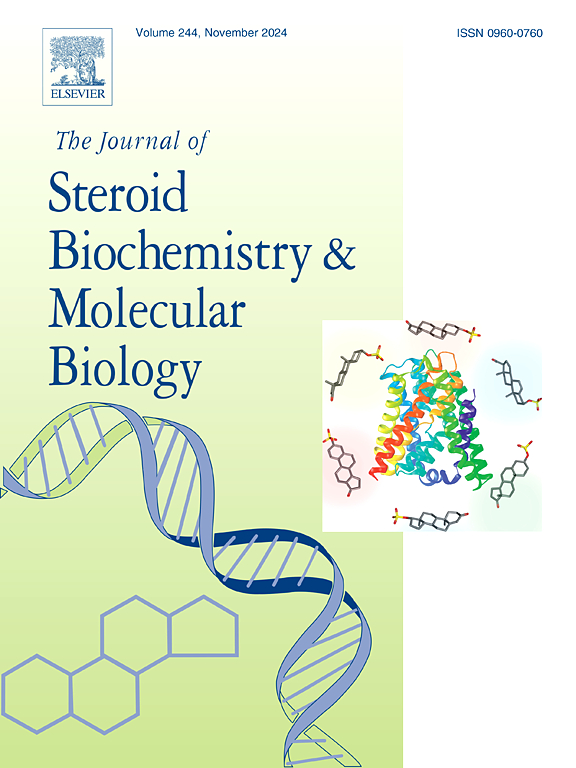甲二酮给药后代谢物结构减少和重排:潜在长期检测的新有前途的代谢物。
IF 2.5
2区 生物学
Q3 BIOCHEMISTRY & MOLECULAR BIOLOGY
Journal of Steroid Biochemistry and Molecular Biology
Pub Date : 2025-06-03
DOI:10.1016/j.jsbmb.2025.106801
引用次数: 0
摘要
间二烯酮(MD)是合成代谢雄激素类固醇的代表,尽管被世界反兴奋剂机构(WADA)列为禁用物质,但在专业和业余体育运动中普遍使用。MD的代谢产物与相关的合成代谢雄激素(AAS)如脱氢氯甲基睾酮(DHCMT)具有高度的结构相似性。这导致了一种假设,即可以检测到与DHCMT长期代谢物结构相似的MD代谢物。因此,我们对MD的人体给药研究进行了分析,重点研究了部分或完全还原a环的代谢物结构,并最终研究了具有17ξ-羟甲基-17ξ-甲基亚结构的重排d环。合成的非对映异构体标准物质可以通过气相色谱-质谱法对排出的目标化合物进行可靠的鉴定和表征。通过这种方法,确定了17α-甲基-5β-雄甾-3α、17β-二醇(T3)、17β-甲基-5β-雄甾-3α、17α-二醇(T7)、17α-羟甲基-17β-甲基-18-不-5β-雄甾-1,13-二烯-3α-醇(N3)、17α-羟甲基-17β-甲基-18-不-5β-雄甾-1,13-二烯-3α-醇(E3)和17,17-二甲基-18-不-5β-雄甾-13-不-3α-醇(3α5βnorTHMT)的排泄。以前已知的和新发现的代谢物的排泄曲线可以评估化学结构与排泄时间之间的关系。除了用新发现的代谢物进一步整合人类对AAS的代谢图谱外,E3的检测使其有望成为未来反兴奋剂分析中新的长期标记物,具有增加检测窗口的适应症。本文章由计算机程序翻译,如有差异,请以英文原文为准。
Reduced and rearranged metabolite structures after metandienone administration: New promising metabolites for potential long-term detection
Metandienone (MD) is a representative of the group of anabolic androgenic steroids and is commonly used in professional and amateur sports despite being a banned substance by the World Anti-Doping Agency (WADA). Metabolites of MD show high structural similarity to related anabolic androgenic steroids (AAS) such as dehydrochloromethyltestosterone (DHCMT). This led to the hypothesis that metabolites of MD with structures similar to long-term metabolites of DHCMT may be detectable. Therefore, a human administration study of MD was carried out and analyzed with the focus on metabolite structures with partly or fully reduced A-rings and eventually with rearranged D-rings with 17ξ-hydroxymethyl-17ξ-methyl substructures. Synthesized diastereomeric reference material allowed the establishment of a confident identification and characterization of excreted targeted compounds by gas chromatography-mass spectrometry. In this way, the excretion of inter alia 17α-methyl-5β-androstane-3α,17β-diol (T3), 17β-methyl-5β-androstane-3α,17α-diol (T7), 17α-hydroxymethyl-17β-methyl-18-nor-5β-androst-13-en-3α-ol (N3), 17α-hydroxymethyl-17β-methyl-18-nor-5β-androsta-1,13-dien-3α-ol (E3) and 17,17-dimethyl-18-nor-5β-androst-13-en-3α-ol (3α5βnorTHMT) was confirmed. Excretion curves of previously known and newly discovered metabolites enabled the assessment of the relationship between the chemical structure and the time of excretion. In addition to further assembling the picture of human metabolism of AAS with newly discovered metabolites, the detection of E3 allows the presumption to be a promising future candidate for a new long-term marker in anti-doping analyses with indications for an increased detection window.
求助全文
通过发布文献求助,成功后即可免费获取论文全文。
去求助
来源期刊
CiteScore
8.60
自引率
2.40%
发文量
113
审稿时长
46 days
期刊介绍:
The Journal of Steroid Biochemistry and Molecular Biology is devoted to new experimental and theoretical developments in areas related to steroids including vitamin D, lipids and their metabolomics. The Journal publishes a variety of contributions, including original articles, general and focused reviews, and rapid communications (brief articles of particular interest and clear novelty). Selected cutting-edge topics will be addressed in Special Issues managed by Guest Editors. Special Issues will contain both commissioned reviews and original research papers to provide comprehensive coverage of specific topics, and all submissions will undergo rigorous peer-review prior to publication.

 求助内容:
求助内容: 应助结果提醒方式:
应助结果提醒方式:


